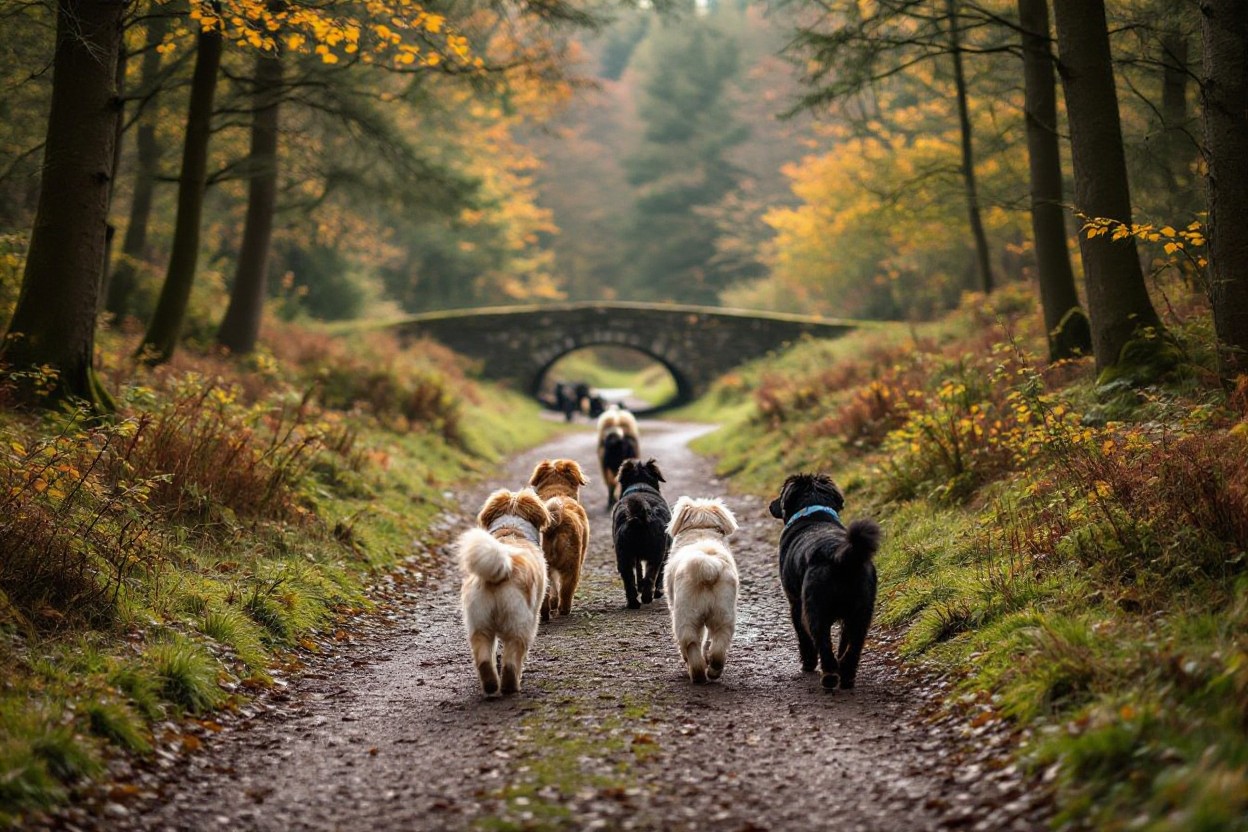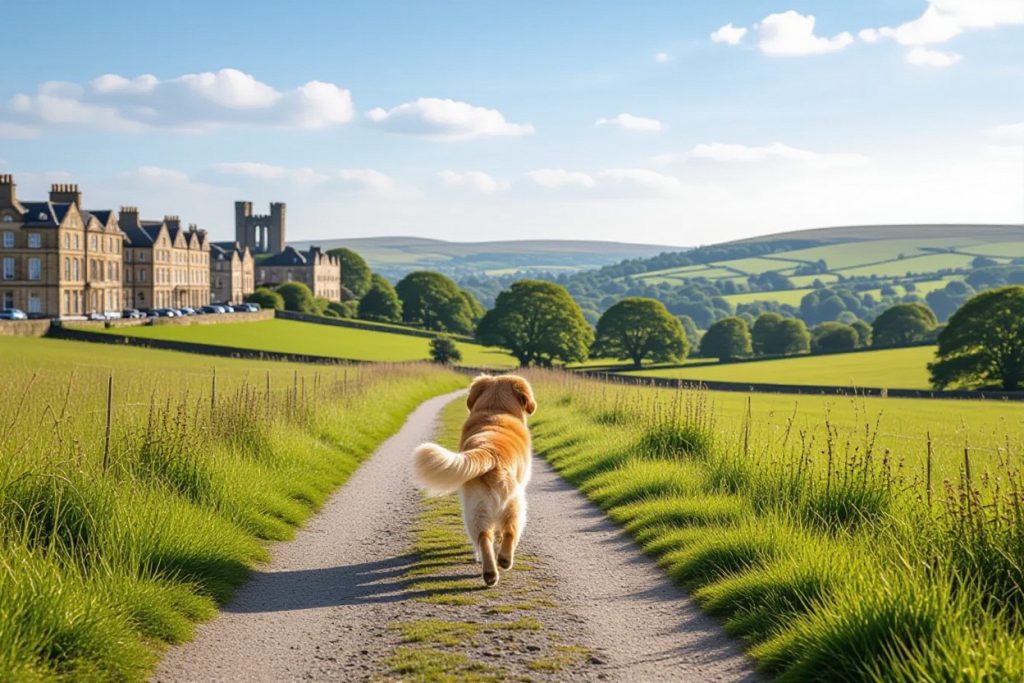You’ll love exploring dog-friendly trails around Harrogate and Knaresborough, from Harrogate’s Stray, Valley Gardens and Harlow Carr to riverside walks by Knaresborough Castle and the Nidd; Nidderdale’s rolling dales and Nidd Gorge offer peaceful woodland and riverbank routes. The area’s mix of open lawns, historic townscapes, cafés and varied terrain makes walks scenic and social, while well-marked paths and nearby parking keep outings easy for you and your dog.

Types of Dog Walking Trails
You’ll find a mix of flat town routes, riverside paths and moorland rambles around Harrogate and Knaresborough that suit every dog and fitness level; the Victorian parks and the River Nidd corridor are especially popular for their scenery and easy access, while nearby Brimham Rocks and Nidderdale give you expansive views and boulder-hopping fun for more adventurous pups.
| Parks & Green Spaces | Valley Gardens, The Stray, Knaresborough Castle grounds — lawns, flowerbeds, easy footing |
| Riverside Walks | River Nidd routes in Knaresborough and Harrogate — gentle gradients, viaduct views |
| Woodland Trails | Nidd Gorge, Harlow Carr woods — shaded paths, roots and stepping stones |
| Countryside Paths | Brimham Rocks, Nidderdale ways — open moorland, stiles, panoramic vistas |
| Historic & Town Trails | Knaresborough town loops, Harrogate Montpellier — cobbles, cafés, short cultural walks |
- Check local parking at Bilton or Knaresborough station for easy access to trailheads.
- Pack water and a towel—mud and river crossings are common after rain.
- Use short leads around wildlife or steep stone viaducts for safety.
- After a riverside loop, plan a stop at a dog-friendly café or bench by the viaduct.
Parks and Green Spaces
You can stroll the manicured paths of Valley Gardens or let your dog run on wide stretches of The Stray in Harrogate; Knaresborough Castle grounds give you a short historic loop with great views over the River Nidd, while smaller green pockets around the town provide quick, grassy breaks between longer routes.
Riverside Walks
You’ll enjoy River Nidd paths that thread through Knaresborough and Harrogate, offering flat towpaths, scenic viaduct viewpoints and close-up wildlife like herons and kingfishers, making these ideal for steady, scenic walks that suit older dogs or families with puppies.
Many riverside routes range from short 1–2 mile loops around Knaresborough viaduct to longer 4–6 mile stretches following the Nidd toward Nidd Gorge; expect muddy sections and occasional stiles, with clear signage at main car parks and frequent access points for a quick exit. You can combine a riverside stroll with nearby attractions—park by the castle, follow the towpath past Bebra Gardens, then head upstream for quieter banks and reedbeds; keep your dog on a lead around weirs and steep drops, and watch for seasonal flooding on low sections. After your riverside walk, warm up with a brew in a dog-friendly Harrogate tea room or relax by a riverside bench in Knaresborough.

Tips for a Great Dog Walk
You’ll get the most from Harrogate’s Stray, Knaresborough riverside walks and Nidd Gorge by planning varied routes: combine sniffing time with brisk stretches along Brimham Rocks, Washburn Valley and Nidderdale AONB loops of 3–6 miles. Cafés in Harrogate and views from Knaresborough Castle make breaks rewarding, while riverbanks and open commons suit dogs of different energy levels. The local paths are mostly well drained and dog-friendly.
- Check weather and ground conditions before you set out.
- Pack a collapsible bowl, 500ml water per hour and dog-safe treats.
- Use a padded harness and a 2–3 metre lead on mixed terrain.
- Keep dogs on lead around livestock and in enclosed town areas.
- Do a full tick-check within 24 hours of moorland or long-grass walks.
Preparing Your Dog
Build up to longer Nidderdale or Washburn Valley routes with short daily walks and occasional hill repeats; fit a padded harness to protect the neck and use a 2–3 metre lead for uneven paths. Carry a lightweight waterproof coat for sudden North Yorkshire showers, a spare towel for riverside stops, and boots if your dog gets sore paws on brambles or grit. Train recall with high-value treats on quieter parts of the Stray and riverside.
Safety Considerations
Watch for sheep and lambs on Nidderdale and upland paths—keep your dog on a short lead in fields and avoid chasing; check for ticks within 24 hours after moorland or long-grass walks and remove with fine-tipped tweezers. River Nidd can surge after rain—use a long line near steep banks and avoid crossing swollen streams. Carry a charged phone, local map and basic first-aid items for cuts or paw wear.
If you find a tick, use fine-tipped tweezers to pull steadily without twisting, clean the bite with antiseptic and note the date; watch for lameness or flu-like signs over the next 30 days and consult your vet. If livestock react, release the lead so your dog can move freely away, then retrieve once calm. Avoid wading into fast water—use a throw line or call local rescue if a dog is swept downstream.
Step-by-Step Guide to Choosing the Right Walk
| Step | What to check |
|---|---|
| Assessing Your Dog’s Needs |
Check your dog’s age, breed, energy and any medical limits: puppies usually need short 10–20 minute outings, adults vary by breed, seniors prefer gentler 20–40 minute strolls; factor in recall and social skills so you can pick busy Stray lawns or quieter valley paths safely. |
| Matching Terrain to Experience |
Match terrain to your dog’s fitness and paw health: paved Valley Gardens paths suit older dogs, riverside trails by the River Nidd in Knaresborough give softer footing and swims for water lovers, while rocky moorland around Brimham or Nidderdale needs sure-footed, fit dogs and a longer lead. |
Assessing Your Dog’s Needs
Start by listing your dog’s age, breed tendencies, energy level and any joint or breathing issues so you can pick suitable nearby routes. If your dog is a young spaniel, you might plan 45–60 minute outings with water stops along the River Nidd; for older labradors choose paved loops in Valley Gardens and frequent rests on benches.
Matching Terrain to Experience
Pick surfaces that suit your dog’s paws and fitness: smooth tarmac and compact gravel in Harrogate work well for dogs with arthritis, while looser, rooty tracks in Nidderdale build stamina for active breeds. Consider seasonal factors—muddy riverside stretches after rain can be slippery and hot exposed moorland demands shade and water in summer.
For practical choices in the area, you can walk paved paths through Valley Gardens for a tidy 20–30 minute loop, take the Stray’s wide grass for off-lead practice, stroll from Knaresborough Viaduct down to Bebra Gardens for gentle riverside exercise, or head to the Nidderdale ridge and Brimham Rocks for steeper, rockier training sessions—always carry water, a first-aid wipe, and a longer lead where sheep graze.
Factors to Consider When Walking Dogs
Pick routes and timing to match your dog’s age and energy, using local favourites like RHS Harlow Carr, The Stray and Nidd Gorge for variety; typical short loops are 1–3 miles.
- Weather and surface (mud, heat on pavements)
- Other dogs and people—peak times at Valley Gardens and Knaresborough market
- Water access and wildlife (River Nidd, fields)
- Local rules—on-lead zones near cafes and historic sites
Any time you head out, check recent trail reports and pack water.
Weather Conditions
Summer often brings mid-20s°C days, so you should avoid walking between 11:00 and 16:00 on hot spells and test pavements with the back of your hand; carry at least 500ml water per dog for a 1–2 hour outing. Winters leave Nidd Gorge muddy and Knaresborough Castle paths icy, so shorten routes, wear grippy boots, and towel paws after wet walks to prevent infections.
Other Dogs and People
On busy weekends Valley Gardens and The Stray can host dozens of dogs and families, so keep your dog on a loose lead near playgrounds and use a long line in open fields to allow sniffing while maintaining control; offer calm greetings and reward settled behaviour to reduce stress.
Plan to avoid peak times when possible—aim for weekday mornings or late afternoons to dodge crowds; keep a 5–10m buffer from unfamiliar dogs and watch for stiff bodies, raised hackles or fixed staring as signs to create space. Practice 5–10 minute recall and calm-sit drills before off-lead moments, carry high-value treats around cafes in Harrogate, and use a short lead for quick correction on narrow Knaresborough streets. If your dog reacts, detour to quieter Harlow Carr paths or trim the walk to a calm, controlled route.
Pros and Cons of Popular Dog Walking Spots
You’ll notice a mix of wide open spaces, formal gardens and riverside paths around Harrogate and Knaresborough that suit different dogs and moods. The Stray offers roughly 200 acres for sprinting, Harlow Carr gives sheltered woodland trails, and Knaresborough’s riverside and castle provide scenic, shorter loops. You can pick a busy, amenity-rich walk or a quieter estate route depending on your dog’s energy, social skills and your preference for parking or cafés nearby.
| Pros | Cons |
|---|---|
| Valley Gardens: manicured lawns, ponds and clear paths for easy walking | Can be crowded on weekends and during floral events, limiting off-lead time |
| RHS Harlow Carr: varied gardens, woodland trails and a dog‑friendly tearoom | Entry fee at peak times and some planted areas restrict free roaming |
| The Stray: about 200 acres for long runs and socialising with other dogs | Exposed to weather; large dog groups can form and spook nervous dogs |
| Nidd Gorge: riverside woodland, boardwalks and varied terrain | Muddy in winter, narrow sections create bottlenecks with other walkers |
| Knaresborough riverside & Castle: stunning views and café stops | Steep steps and summer tourists make parts congested and tricky on-lead |
| Ripley Castle Estate: quieter estate loops and lakeside walking off-peak | Access may be limited when events or grazing livestock are present |
| Local woodland tracks (Cold Bath, Bilton): shady, cool during summer | Parking is often limited and trails can be uneven for older dogs |
| Town promenades and cafés: handy for short, social walks and refreshment | Busy streets and unclear dog policies in some shops create friction |
Benefits of Harrogate’s Parks
You can enjoy a mix of formal and wild spaces in Harrogate that suit every dog: Valley Gardens for gentle strolls, The Stray for long runs, and Harlow Carr for shaded trails and seasonal displays. Many paths are well maintained, cafés welcome muddy paws, and regular planting schemes mean colourful views year-round. Strong footpaths and plenty of benches make it easy to manage puppies, older dogs or multi-dog walks while taking in that classic spa-town charm.
Drawbacks of Busy Areas
You’ll find peak crowds at Knaresborough Castle, the riverside and central Harrogate on sunny weekends and bank holidays, which can stress reactive dogs and make on-lead navigation awkward. Narrow viaduct paths and steep steps at popular viewpoints concentrate people and pushchairs into tight spaces, increasing the chance of tense encounters or startled wildlife. Parking and litter are common issues near hotspot car parks.
Festival days and seasonal events regularly draw thousands to Harrogate and Knaresborough—flower shows, fairs and summer markets can double local footfall. Aim for weekday mornings or late afternoons to avoid the busiest windows (typically 10:00–16:00 at weekends). You can also escape crowds by choosing Ripley Estate, quiet stretches of Nidd Gorge or woodland feeders off the main routes; bringing a long line, water and waste bags helps you handle sudden pinch points or children approaching your dog.
Local Amenities for Dog Walkers
Harrogate and Knaresborough give you plenty of practical support on your walks: dog bins and parking around the Stray and Valley Gardens, water points and cafés at Harlow Carr, clear riverside paths along the River Nidd, and regular group walks that start from Harrogate town centre and Knaresborough market—perfect for linking short 2–3 mile loops to longer Nidderdale outings.
Pet-Friendly Cafés
You can stop at several pet-friendly cafés in Montpellier and around Cold Bath Road where outdoor seating, water bowls and dog treats are common; Harlow Carr’s garden café and Valley Gardens’ tearooms welcome dogs on leads, making them great post-walk pit-stops after a riverside stroll or a longer walk into the Nidderdale hills.
Dog Supply Shops
Harrogate town centre and Knaresborough High Street host independent pet shops and national outlets where you can pick up food, harnesses, leads and locally made treats, plus book grooming or training sessions—handy if you want same-day supplies before heading out to the Stray or the viaduct walk.
Look for shops that offer free harness fittings and sample packs so you can test new kibble before committing; many independents also provide tailored nutrition advice, canine-first-aid kits, clicker-training classes or referrals to local groomers who do nail trims and deshedding—useful services if you walk daily on varied terrain around Harrogate and Nidderdale.
Conclusion
Taking this into account, you’ll find excellent dog walks from Harrogate’s Stray, Valley Gardens and RHS Harlow Carr to Knaresborough’s riverside paths, Nidd Gorge and Nidderdale AONB, offering varied trails, parks and riverbanks. The area’s floral displays, gentle hills and historic charm make walking a pleasure, while Harrogate’s spa-town parks and Knaresborough’s castle, viaduct and cafés attract you and your dog to scenic routes and friendly stops.
FAQ
Q: What makes North Yorkshire — especially Harrogate and Knaresborough — such a great area for dog walking?
A: The area combines varied landscapes in a compact radius: tree-lined riverside trails along the River Nidd, parkland and formal gardens in Harrogate, dramatic limestone edges and moorland on the outskirts, plus historic towns and green commons. Nidderdale AONB and nearby moorland give wide open space and views; rivers, reservoirs and wooded gorges offer shade, scent and water for dogs. Harrogate’s Victorian parks and Knaresborough’s riverside, viaduct and castle create interesting short walks with plenty of places to stop for drinks or shelter, so routes suit everything from quick urban outings to full-day hikes.
Q: What are the best dog walks in and around Harrogate?
A: Valley Gardens — formal beds, fenced play areas, wide paths and a stream make it ideal for easy outings. The Stray — seven miles of open common through town for off-road strolling and social dogs. RHS Harlow Carr — woodland trails and terrace views (follow site rules about dogs and paths). Nidd Gorge (access from Bilton/Harlow Hill) — steep-sided woodland with tunnels and boardwalks for an atmospheric riverside walk. For water and longer routes, head a few miles west to Swinsty and Fewston reservoirs for lakeside paths and moorland links.
Q: What are the best dog walks in and around Knaresborough?
A: Riverside walk from the viaduct — scenic riverside path past Bebra Gardens and along the Nidd with places for dogs to paddle. Knaresborough Castle grounds — lawns and viewpoints over the river; short, dramatic loop. Starbeck/Bilton to Knaresborough — riverside and Nidd Gorge sections combine into a longer riverside ride. Castle Howard and nearby country lanes also offer quiet, varied walks within a short drive. Many town cafés and pubs are dog-friendly, so Knaresborough suits walkers who want a mix of nature and amenities.
Q: Where can I find longer or more adventurous walks near Harrogate and Knaresborough?
A: Nidderdale AONB offers extensive upland routes, quiet lanes and moor-top stretches for full-day hikes. Brimham Rocks (to the north) provides dramatic gritstone formations and open moorland; it’s popular for scrambling and photography. Fountains Abbey and Studley Royal Water Garden give a long heritage walk through parkland and riverside ruins. Reservoir circuits at Fewston, Swinsty and Fewston link into moorland paths and are good for varied terrain and water access.
Q: What practical tips should walkers follow around Harrogate and Knaresborough?
A: Check local signage for lead requirements and protected areas; many pubs and cafés welcome dogs but policies vary. Bring water and a bowl, poo bags, a short lead for busy town stretches, and a longer lead for open commons where allowed. In wetter months expect muddy sections, and on moors prepare for wind and exposure. Ticks and burrs can be an issue after warm spells—inspect coat and paws after walks. Use marked car parks to avoid fines, and plan parking for busy spots like Valley Gardens, Harlow Carr and popular reservoir trailheads.

